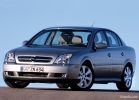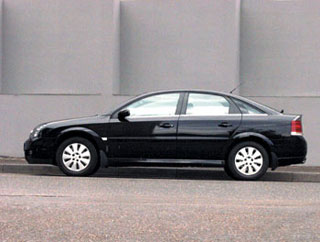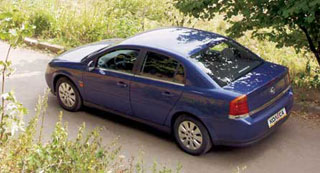Test drive Opel Vectra sedan 2002 - 2005 sedan
Movement energy
The third -generation Opel Vectra can rightfully be considered a bestseller of the Belarusian market. Appearing a little more than two years ago, Vectra immediately became one of the most popular representatives of their class. You can easily verify this by watching the flow of cars on one of the central streets of the capital. And today we have a new modification of Opel Vectra on the test-with a 2.2-liter 125-horsepower turbodiesel.Actually, the vector is offered as many as three diesel engines-an indicator that even Mercedes-Benz can envy with its huge gamut of diesel engines. The first, the smallest, has a working volume of two liters and develops a power of 101 hp. The second version is the one that was on the test today. About its characteristics a little later, but for now, imagine the most-most turbodiesel. Impress: three (!!!) liters, 176 horses and a torque of 350 nm. Previously, a few years ago, such engines, which are literally in several manufacturers, were installed only on business class model. And now Opel also suggested that the owners of medium -sized cars enjoy the unprecedented power and the torque. However, as sales statistics show are so very powerful, but quite expensive versions are not very often found. Therefore, let's return to our intermediate Vectra with a 2.2-liter turbodiesel.
The energy supply of this car can be envied by many competitors. Under the hood - a four -cylinder engine with a capacity of 125 hp. The maximum torque indicator is 280 nm. In addition, the peak of the torque is unrealistically low 1500 rpm, which is a kind of dignity, because most modern turbodiesel engines begin to spin only from 2000 rpm, when a turbine comes into business.
For this version of Opel Vectra, two types of transmissions are provided: a mechanical five -speed and automatic, also five -stage. The car provided for the test was an automatic. Permanent readers probably remember that Opel with this combination of turbodiesel+the machine was already on the tests of AG. Only last time it was not quite Vectra. More precisely, not such a Vectra. In general, it was Opel Signum - a representative class hatchback, created on the basis of vetera. That's what we met with an automatic machine and a turbodiesel.
But now, when on the Opel Vectra 2.2 dti test, we are tormented by vague doubts: is this the same motor and the same transmission? Then it is not clear what prevented us from evaluating them last time, during the Opel Signum test. If you remember, the motor received for noise during acceleration and tractor chatter at idle, and the machine went for incomprehensible shocks at the time of stopping and touching the car. And therefore, in the overall rating of the chassis of Zignum, a low ball was awarded. With the reservation that these claims are not related to the representative of the new class of cars.
Is it strange? That car had exactly the same motor and transmission, but the sensations from them, believe me, were completely different. Either because Zignum is a little heavier, or because he travels as a representative of a higher class, but we categorically did not like the engine or transmission on the representative hatchback. Vectra is a completely different matter!
It accelerates somehow livelier, and the machine operates more adequately - delays with sharp changes in the movement mode remained, but now they are not so noticeable. You do not pay attention to them at all - the car gains speed easily, under the unobtrusive nook of the motor. And there are no pushes noticed on Zignum here - both in the kick of Down, and in the manual and automatic modes, the machine conquers primarily smooth operation. He is clearly not an athlete, because the programs in any case switch about a second after serving the command. But no matter how you gas, the change of transmission will not be accompanied by unpleasant shocks or vibrations.
Two automatic operating modes are provided: ordinary and manual, which is turned on by the translation of the automatic transmission lever from position D to the left, to itself. And shaking the lever back and forth, the transmission can be changed forcibly, forcing the car either hanging at high speeds, preparing for a sharp overtaking, or, conversely, use increasing transmissions at low speeds, taking care of fuel saving. For example, having turned on the highest gear on 70 km/h, you can lower the engines by about 1000-1400 rpm, as a result of which the fuel consumption will be minimal.
The turbodiesel vector also turned out to be one of the few cars on which you can drive in manual mode of operation. When the maximum revolutions are reached, when the tachometer arrow was already falling into the red zone, the box switches up and does this, as mentioned above, very, very smoothly. And the car responds to the discharge of gas with very intense braking by the engine, which is very convenient under the current weather conditions. In special cases, slowing down can be made even more intense - shaking the automatic transmission lever on yourself, you forcibly turn on the lowering gear, sharply reducing the speed of movement. In other cars, and the majority of such in the middle class, the manual mode is sharply working - their boxes are also switched, but they do it so sharply that the car twitches and squats the front at the time of switching. And braking by the engine also turns out to be either not effective or too sharp. So for the settings of the machine gun, the Germans can be complimented. By the way, this compliment will also relate to the Japanese from Aisin, whose machine gun is installed on Opel Vectra. Yes, on the German car there is an automatic transmission of Japanese production, so you can not worry about the reliability and resource of this unit.
It is only a pity that the engine noise did not decrease: the turbodiesel is all the same as on Zignum, clearly declares itself at idle and overclocking. Standing at the intersection, you have to listen to a characteristic low -frequency rod and feel vibrations on the steering wheel. It is not easier at acceleration: as soon as the tachometer arrow rises from the idle zone, it becomes noisy in the cabin. Yes, it would not hurt to work on sound insulation. However, they seemed to work on her. And long and thoroughly. Later it turned out that the noise of the motor in the entire speed range remains approximately the same. That is, for 2000 rpm, that for 5000 rpm for the passenger the motor sounds the same - not very loud, but clearly.
It seemed especially funny when Vectra accelerated to 180 km/h under the measured rumble of the Vectra turbodiesel. Moreover, she did this, according to the indications of the screen on the instrument panel, in the fourth gear. But despite the fact that the tachometer arrow at such a speed hung somewhere opposite the number 6, in the cabin you could talk without raising the voice. Having slightly dropped the gas and turning on the fifth gear, we came to the conclusion that the motor began to work only a little quieter.
In this place, we again want to return to the settings of the machine again. The best acceleration, as we found out in the course of several races along the ring, the machine provides a manual transmission of automatic transmission, when, with a gas pedal, which controls the transmission, the transmission itself changes when the maximum revolutions squeezed to the policeman. So, it turned out that the machine, even in manual mode, not only switches up and turns on lower gears when reducing speed, but also very actively uses Kick Down. For example, if you accelerated to 140 km/h, then reduced the speed to 80-90 km/h and hit the right pedal again, then the machine, without thinking for a long time, will turn on the third gear - in order to achieve maximum acceleration. Usually, in other models, machine guns allow themselves to turn on the maximum fourth gear, and they never use lower, fearing to twist the engine. Honestly, this ability of the Aisin gearbox was a pleasant surprise for us and representatives of Opel.
We will not particularly spread about the settings of the chassis and steering of Opel Vectra, we will only say that this is still a very fast and maneuverable machine, which allows you to feel confident both on the autobahn and in a steep turn. The steering wheel, slightly empty at low speed, after 120 km/h is poured with pleasant weight - now you need to make a slight effort to move it. Although there is no clear zero on the steering wheel - as one of my colleagues expresses, you sneeze at such speed - and you won’t notice how you will leave the road.
What to say about the turbodiesel vector? It is noticeably better than diesel Ford Mondeo - quieter, more dynamic, more elastic. It is younger than the VW Passat, and cheaper than the Audi A4, the 130-horsepower turbodiesel is very good. It turns out that Opel Vectra occupies in the middle grade a position that is fully consistent with its advantages. She does not reach the level of expensive BMW and Mercedes-Benz, but among ordinary representatives of the middle class she feels very confident. Its advantages are fresh design, high -quality interior decoration, a painful and economical turbodiesel, as well as a very low retail price. And to a few disadvantages, you can reckon the noise of the engine and small vibrations on the steering wheel arising in transition modes. In general, the average rating is a solid five!
Pavel Kozlovsky
A source: Auto -Gazeta / N 9 (448) dated 16.03.04









